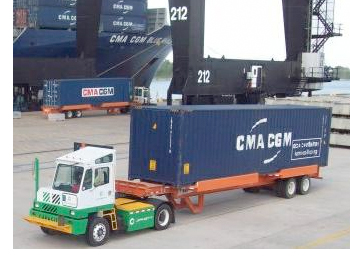| Compliance Summary |
 Compliance Summary Tool Compliance Summary Tool
|
 |
| Transportation Modes |
|
 |
| Service Functions |
|
 |
| Regulations |
|
 |
| All Topics |
|
 |
|
Please note: This summary is provided to help you understand the regulations. Consult the references provided for links to the full text of the regulations.
 Drayage Trucks Drayage Trucks
Who is covered by the regulations?
Owners and operators of short-haul trucks that transport goods between ports, warehouses and local stores.
What is the purpose of the regulations?
Prior to 2007, drayage trucks tended to be older vehicles with little or no emission controls. Reducing emissions from these trucks is necessary to meet federally imposed clean air standards and to reduce adverse health effects - especially to nearby communities.
Regulations
A number of programs that affect drayage carriers have been underway since 2007. These programs, aimed at reducing air emissions, include both mandatory regulations and voluntary programs such as grants and financial incentives. Examples include:
-
In December 2007, the California Air Resources Board (ARB) approved a State-wide Drayage Truck Regulation to reduce emissions from drayage trucks transporting cargo to and from California’s ports and intermodal rail yards. In general, the regulation requires emission reductions from drayage trucks, as well as recordkeeping and reporting to help monitor compliance and enforcement efforts. By January 1, 2014 all Drayage Trucks must operate with a 2007 or newer model year engines.
-
The ports of Los Angeles and Long Beach implemented a clean-truck program in 2008 with a scheduled set of truck bans aimed at reducing truck-related air pollution by 80 percent through 2012. The plan required each truck working at the port to register and meet clean air standards. By the end of 2011, the port complex reported it had reduced trucking pollution by more than 80 percent, with 14,000 trucks replaced.
-
The Port of Oakland adopted a similar program in 2009, targeting an 85 percent emissions reduction by 2020. Diesel emissions were cut by 70 percent through 2012.
-
The ports of Seattle, Tacoma and Metro Vancouver all adopted similar clean-truck programs in 2008 when they signed the Northwest Ports Clean Air Strategy.
-
The Massachusetts Port Authority sponsored a clean-truck program that replaced 60 drayage trucks at the Port of Boston through $1.5 million program.
-
The Port of New York-New Jersey enacted a truck replacement program in 2010, which covered the cost of replacing trucks through a $28 million partnership between the EPA and the port authority. The program ended in 2013 with 429 trucks scrapped and replaced with newer models. New York-New Jersey will stop receiving trucks made before 2007 in 2017.
-
The Port of Virginia works with the Virginia Green Operators Program, started by the Virginia Port Authority in 2006, which not only replaces trucks but retrofits those that don't meet the 2007 EPA standards.
More Resources
|

 Drayage Trucks
Drayage Trucks